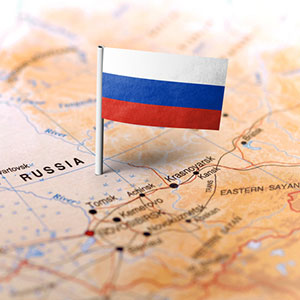
There’s been a lot of talk about how current sanctions language allows for Russian diamonds “substantially transformed” (i.e., cut and polished) elsewhere to enter the United States—which, some say, makes current regulations “worthless.”
Yet, for all those who insist that it’s “business as usual” with Kremlin gems, it clearly is not.
From what we hear (and there’s a real lack of transparency on this subject), Alrosa—the preeminent diamond miner in Russia, which is one-third owned by the Russian government—is still mining and, in some cases, still selling. But the measures the United States and other countries imposed against Alrosa following Russia’s Feb. 24 invasion of Ukraine have seriously impeded its ability to move product.
Market talk says that Alrosa canceled its April sight and does not plan to resume regular allocations until the summer. Its site lists no upcoming auctions. The ordinarily quick-to-respond company did not return JCK’s requests for comment.
It’s very likely that Alrosa’s sales have fallen, perhaps drastically—especially since there was also a post-invasion market slowdown. But there’s no official tally on how much they’ve dropped. Last month, Alrosa suspended publication of both its monthly sales data and its quarterly results. That is not something a company does when things are going well.
“As far as we know, they are holding off on regular sights/sales,” says Tom Neys, spokesperson for the Antwerp World Diamond Centre.
There are occasional “on demand” sales to Antwerp, he says, citing “informal” communications.
“Russian goods are still flowing [into Belgium],” he adds. “We do know that goods that are bought take a very long time before they arrive. Every import creates a lot of extra checks, making sure that goods get to their destination. That creates a difficult process and that means, of course, extra risk is involved. Because of that, it’s hard to say if and how much [volume has dropped].”
However, another plugged-in Antwerp source says, “From what I hear, there’s nothing coming in. The Alrosa representatives in Antwerp have a nice new office and nothing to do.”
Pranay Narvekar, an analyst based in India and head of Pharos Beam Consulting, says, “Currently, there is no flow of Russian diamonds [into India], mainly because of Alrosa being on the OFAC [Office of Foreign Assets Control] list. Banks are not processing the payments.”
Companies on the OFAC list can’t do business in dollars, or with any company with a U.S. presence. In addition, Russia has been banned from the international SWIFT payment system.
“There were a few consignments which came in, but these were ones where payment had been made in February,” he says. “But the physical consignments were stuck due to the start of the conflict.”
Several international shippers don’t want to carry Alrosa goods, and even when they do, underwriters don’t want to insure them.
“Some of the larger companies have found other ways of shipping [them],” mostly through expensive charter flights, says another source. “The volumes are not huge, in any way. The logistics, insurance, no trading in U.S. dollars, are all issues.”
Not only are new Alrosa goods hard to buy, but they are also not that easy to sell, with many buyers shying away.
“U.S. retailers won’t touch Russian goods,” adds one trader. “If retailers ask their suppliers to swear that they’re not selling them, they are basically daring them to lie. And if they’re found out, that’s a problem.”
In addition, online markets such as RapNet have stopped listing sanctioned gems.
Says one veteran dealer: “Russian goods have become toxic.”
Which points to a possible PR issue. Indian, Belgian, and Israeli traders who buy from Alrosa risk getting outed by local newspapers. (This has already happened in Israel.) That is less of an issue in Russia-friendly Dubai, which has little free press and is generally considered the diamond center with the most to gain here.
Narvekar notes that previous U.S. sanctions—against mines in Marange, Zimbabwe—did not have a major impact on the pipeline. But this time looks different. In the past, U.S. retailers have been unwilling to pay any extra costs related to segregating goods by origin. But now, flush with cash and worried about repercussions, they just might.
All of which adds up to a potentially serious situation for Alrosa, which, ironically, has just come off of its best year ever. There’s talk that it might extend credit to its customers—something diamond miners have generally been reluctant to do—which would be a substantial, and possibly risky, undertaking.
The company will “need to get creative in establishing new customer relationships and payment options,” said Igor Kulichik, a former Alrosa chief financial officer, in an interview with Rough and Polished, a Russian publication.
It’s striking to consider: Alrosa spent years building up a first-rate client list, only to see it trashed almost overnight by a foolish and barbaric invasion.
Last week, Reuters quoted Russia’s minister of finance, Anton Siluanov, as saying that Alrosa may start selling to the Gokhran, the state fund of precious metals and precious stones.
This would give it a much-needed helping hand; the Gokhran made a similar offer at the start of the COVID-19 pandemic—which Alrosa eventually spurned, because its prices were too low. Back then, an Alrosa spokesperson called Gokhran sales “a last resort.”
It may be its best option now. Kulichik said that the Gokhran could give Alrosa breathing room to “consistently fulfill all its obligations, maintain the diamond production for six to nine months, and build up a new sales and payment and settlement system during this period.”
Still, having to prop up Alrosa would be another burden for the Russian government, which needs funds for its invasion and is also strapped for cash.
Kulichik also mentioned another issue that could hurt Russian miners that may not be obvious: Alrosa needs “to look for and establish channels for the supply of critical spare parts right now.”
That’s because most mining equipment is still made in the West, which isn’t selling to Russia right now.
Russia’s other miner, Grib, which traditionally accounted for 10% of the country’s production—and is controlled by state-owned VTB Bank, which is also subject to U.S. sanctions—hasn’t sold goods since February, sources tell JCK.
None of us knows how long Russia’s invasion of Ukraine will last. But assuming it drags on, Alrosa may find a way to work around the current rules. By that point, however, there may be different ones.
Needless to say, jewelers and dealers should remain vigilant. There are compelling reasons for U.S. retailers to use best practices to ensure they’re not receiving Russian goods.
But in the absence of firm data, all the available evidence (anecdotal and otherwise) indicates that, for now, the sanctions have significantly slowed sales of Russian goods. Whether they’re helping to achieve their true goal—stopping the war—is a lot harder to know.
(Photo: Getty Images)
- Subscribe to the JCK News Daily
- Subscribe to the JCK Special Report
- Follow JCK on Instagram: @jckmagazine
- Follow JCK on X: @jckmagazine
- Follow JCK on Facebook: @jckmagazine







